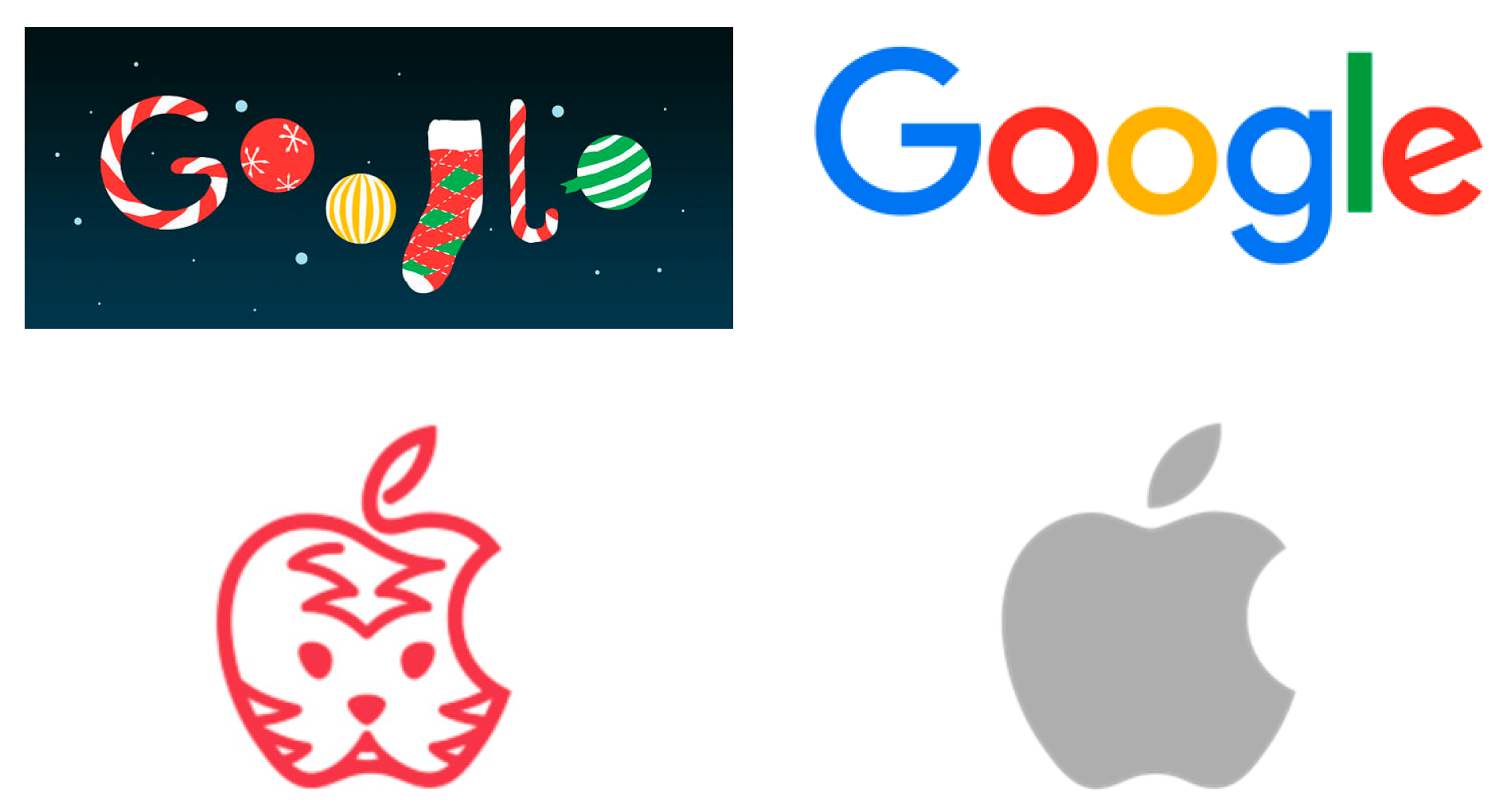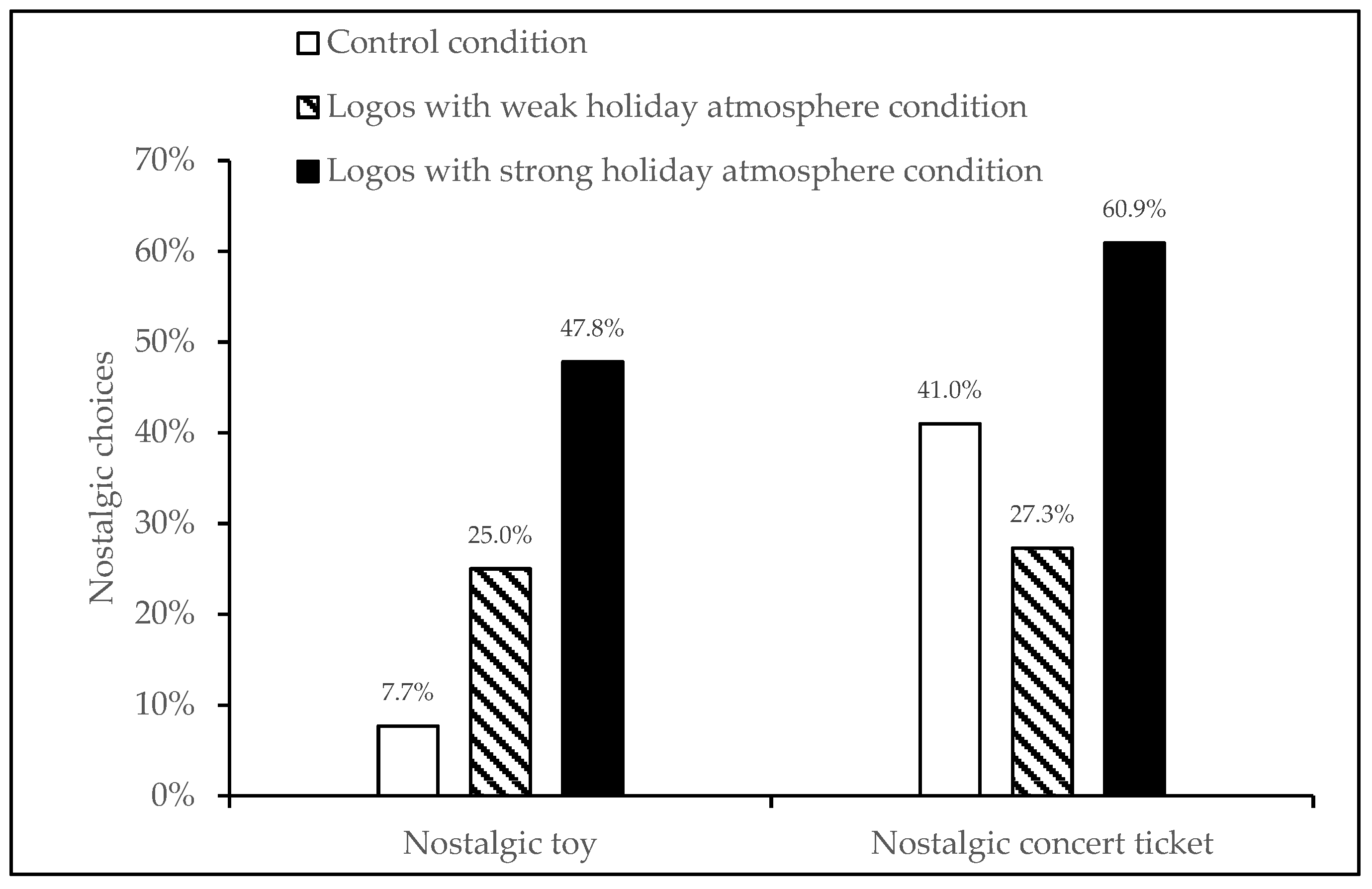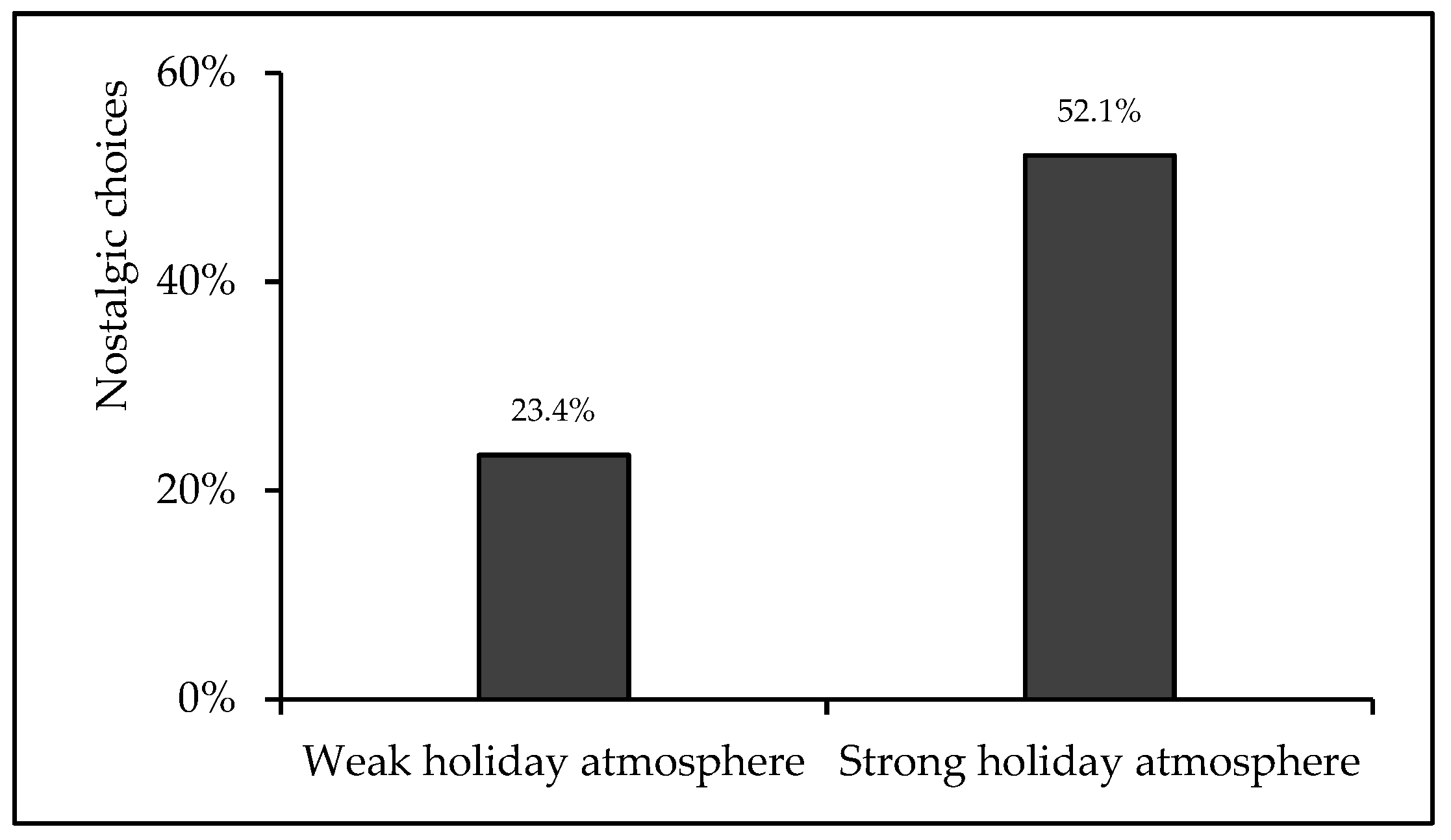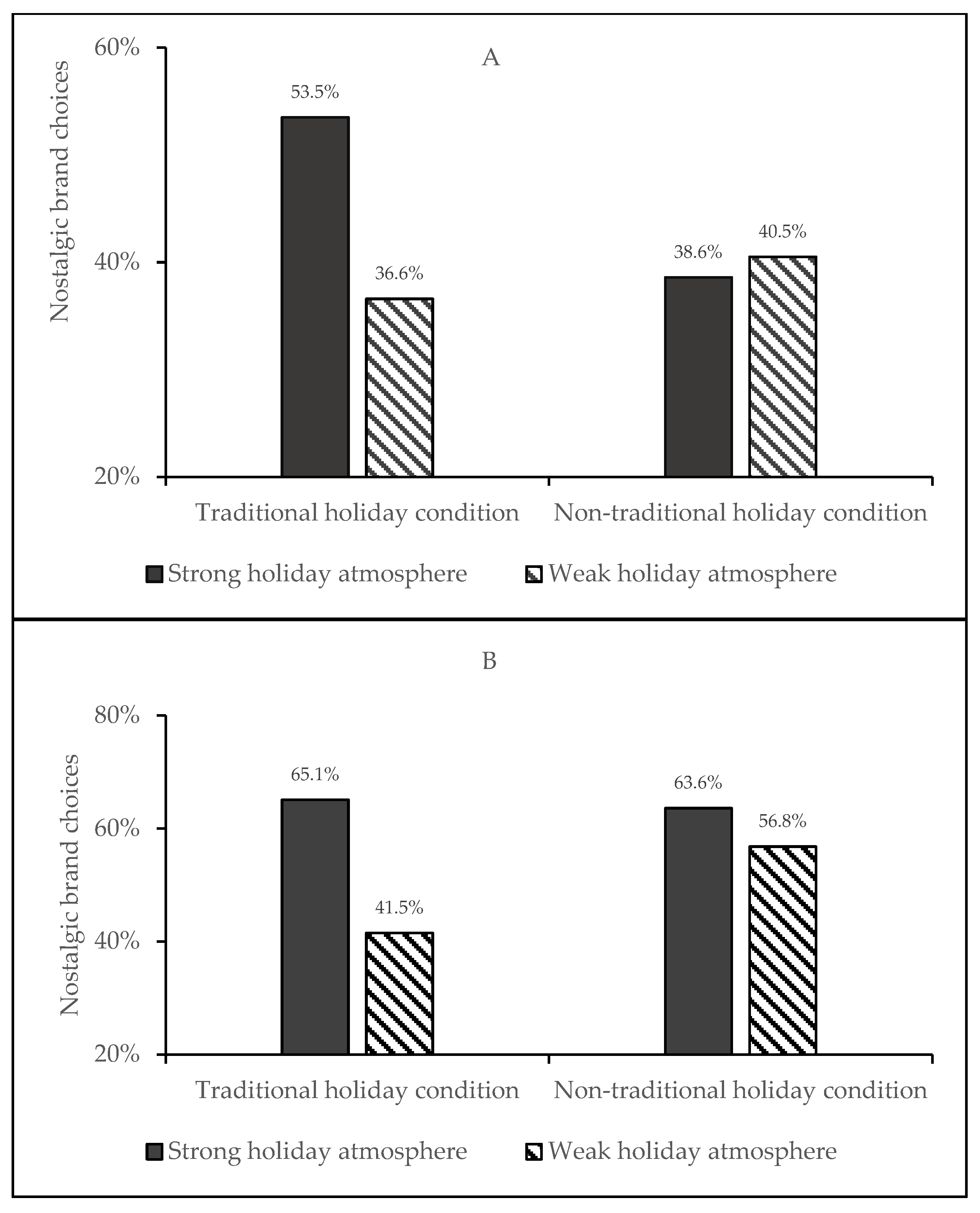It Reminds Me of My Happy Childhood: The Influence of a Brand Logo’s Holiday Atmosphere on Merchandise-Related Nostalgic Preference
Abstract
:1. Introduction
2. Theoretical Framework
2.1. Festivals and Holidays
2.2. Brand Logos
2.3. Nostalgic Preference
2.4. Brand Logo’s Holiday Atmosphere and Consumers’ Merchandise-Related Nostalgic Preference
2.5. Mediating Role of Childhood Imagery
2.6. Moderating Role of Holiday Type
3. Study 1
3.1. Sample and Method
3.2. Results
4. Study 2
4.1. Sample and Method
4.2. Results
5. Study 3
5.1. Sample and Method
5.2. Results
6. Discussion
6.1. Theoretical Contributions
6.2. Practical Implications
6.3. Limitations and Further Research
Author Contributions
Funding
Institutional Review Board Statement
Informed Consent Statement
Data Availability Statement
Conflicts of Interest
Appendix A. Stimulus in Study 1


Appendix B. Stimulus in Study 2 and Study 3


Appendix C. Stimulus in Study 3


References
- Chen, C.; Li, X. Effects of Singles’ Day atmosphere stimuli and Confucian values on consumer purchase intention. Asia Pac. J. Mark. Logist. 2019, 32, 1387–1405. [Google Scholar] [CrossRef]
- Zhao, L. The similarities and differences between the Spring Festival in China and Christmas in America. In 3rd International Conference on Education, Sports, Arts and Management Engineering (ICESAME 2018); Atlantis Press: Amsterdam, The Netherlands, 2018. [Google Scholar]
- Cartwright, J.; McCormick, H.; Warnaby, G. Consumers’ emotional responses to the Christmas TV advertising of four retail brands. J. Retail. Consum. Serv. 2016, 29, 82–91. [Google Scholar] [CrossRef]
- Pine, K.J.; Wilson, P.; Nash, A.S. The relationship between television advertising, children’s viewing and their requests to Father Christmas. J. Dev. Behav. Pediatrics 2007, 28, 456–461. [Google Scholar] [CrossRef] [Green Version]
- Buijzen, M.; Valkenburg, P.M. The impact of television advertising on children’s Christmas wishes. J. Broadcasting Electron. Media 2000, 44, 456–470. [Google Scholar] [CrossRef]
- Spangenberg, E.R.; Grohmann, B.; Sprott, D.E. It’s beginning to smell (and sound) a lot like Christmas: The interactive effects of ambient scent and music in a retail setting. J. Bus. Res. 2005, 58, 1583–1589. [Google Scholar] [CrossRef]
- Luffarelli, J.; Stamatogiannakis, A.; Yang, H. The visual asymmetry effect: An interplay of logo design and brand personality on brand equity. J. Mark. Res. 2019, 56, 89–103. [Google Scholar] [CrossRef]
- Luffarelli, J.; Mukesh, M.; Mahmood, A. Let the Logo Do the Talking: The Influence of Logo Descriptiveness on Brand Equity. J. Mark. Res. 2019, 56, 862–878. [Google Scholar] [CrossRef]
- Cian, L.; Krishna, A.; Elder, R.S. This Logo Moves Me: Dynamic Imagery from Static Images. J. Mark. Res. 2014, 51, 184–197. [Google Scholar] [CrossRef] [Green Version]
- Kelemen-Erdős, A.; Fekete, R. Factors involved in Hungarian Sports Fans’ Attendance and Merchandise-related Decisions. Obuda Univ. e-Bull. 2017, 7, 1–5. [Google Scholar]
- Baker, S.M.; Kennedy, P.F. Death by Nostalgia: A Diagnosis of Context-Specific Cases. ACR N. Am. Adv. 1994, 21, 169–174. [Google Scholar]
- Belk, R.W. The role of possessions in constructing and maintaining a sense of past. ACR N. Am. Adv. 1990, 17, 669–676. [Google Scholar]
- Zhou, L.; Wang, T.; Zhang, Q.; Mo, Y. Consumer insecurity and preference for nostalgic products: Evidence from China. J. Bus. Res. 2013, 66, 2406–2411. [Google Scholar] [CrossRef]
- Wu, Z.; Chen, Y.; Geng, L.; Zhou, L.; Zhou, K. Greening in nostalgia? How nostalgic traveling enhances tourists’ proenvironmental behaviour. Sustain. Dev. 2020, 28, 634–645. [Google Scholar] [CrossRef]
- Han, M.; Newman, G.E. Seeking Stability: Consumer Motivations for Communal Nostalgia. J. Consum. Psychol. 2022, 32, 77–86. [Google Scholar] [CrossRef]
- Hirsch, A.R. Nostalgia: A neuropsychiatric understanding. ACR N. Am. Adv. 1992, 19, 390–395. [Google Scholar]
- Davis, F. Yearning for Yesterday: A Sociology of Nostalgia; Free Press: New York, NY, USA, 1979. [Google Scholar]
- Loveland, K.E.; Smeesters, D.; Mandel, N. Still Preoccupied with 1995: The Need to Belong and Preference for Nostalgic Products. J. Consum. Res. 2010, 37, 393–408. [Google Scholar] [CrossRef]
- Holak, S.L.; Havlena, W.J. Nostalgia: An exploratory study of themes and emotions in the nostalgic experience. ACR N. Am. Adv. 1992, 19, 380–387. [Google Scholar]
- Falassi, A. Festival: Definition and morphology. Time Out Time: Essays Festiv. 1987, 1, 1–10. [Google Scholar]
- Xu, R. Research on Chinese and Western Traditional Festival Culture Contrast. In 2014 2nd International Conference on Education Technology and Information System (ICETIS 2014); Atlantis Press: Amsterdam, The Netherlands, 2014. [Google Scholar]
- Rook, D.W. The ritual dimension of consumer behavior. J. Consum. Res. 1985, 12, 251–264. [Google Scholar] [CrossRef]
- Bradford, T.W.; Sherry, J.F., Jr. Domesticating public space through ritual: Tailgating as vestaval. J. Consum. Res. 2015, 42, 130–151. [Google Scholar] [CrossRef] [Green Version]
- Gurau, C.; Tinson, J. Early evangelist or reluctant Rudolph? Attitudes towards the Christmas commercial campaign. J. Consum. Behav. 2003, 3, 48. [Google Scholar] [CrossRef]
- Minowa, Y.; Khomenko, O.; Belk, R.W. Social change and gendered gift-giving rituals: A historical analysis of Valentine’s Day in Japan. J. Macromark. 2011, 31, 44–56. [Google Scholar] [CrossRef]
- Weinberger, M.F. Dominant consumption rituals and intragroup boundary work: How non-celebrants manage conflicting relational and identity goals. J. Consum. Res. 2015, 42, 378–400. [Google Scholar] [CrossRef]
- Kokthi, E.; Thoma, L.; Saary, R.; Kelemen-Erdos, A. Disconfirmation of Taste as a Measure of Trust in Brands: An Experimental Study on Mineral Water. Foods 2022, 11, 1276. [Google Scholar] [CrossRef]
- Septianto, F.; Paramita, W. Cute brand logo enhances favorable brand attitude: The moderating role of hope. J. Retail. Consum. Serv. 2021, 63, 102734. [Google Scholar] [CrossRef]
- Hagtvedt, H. The impact of incomplete typeface logos on perceptions of the firm. J. Mark. 2011, 75, 86–93. [Google Scholar] [CrossRef] [Green Version]
- Miceli, G.N.; Scopelliti, I.; Raimondo, M.A.; Donato, C. Breaking through complexity: Visual and conceptual dimensions in logo evaluation across exposures. Psychol. Mark. 2014, 31, 886–899. [Google Scholar] [CrossRef]
- Xu, X.; Chen, R.; Liu, M.W. The effects of uppercase and lowercase wordmarks on brand perceptions. Mark. Lett. 2017, 28, 449–460. [Google Scholar] [CrossRef]
- Henderson, P.W.; Giese, J.L.; Cote, J.A. Impression Management Using Typeface Design. J. Mark. 2004, 68, 60–72. [Google Scholar] [CrossRef] [Green Version]
- Jiang, Y.; Gorn, G.; Galli, M.; Chattopadhyay, A. Does Your Company Have the Right Logo? How and Why Circular- and Angular-Logo Shapes Influence Brand Attribute Judgments. J. Consum. Res. 2015, 42, 709–726. [Google Scholar] [CrossRef]
- Labrecque, L.I.; Milne, G.R. Exciting red and competent blue: The importance of color in marketing. J. Acad. Mark. Sci. 2012, 40, 711–727. [Google Scholar] [CrossRef]
- Gorn, G.J.; Chattopadhyay, A.; Sengupta, J.; Tripathi, S. Waiting for the web: How screen color affects time perception. J. Mark. Res. 2004, 41, 215–225. [Google Scholar] [CrossRef] [Green Version]
- Dong, R.; Gleim, M.R. High or low: The impact of brand logo location on consumers product perceptions. Food Qual. Prefer. 2018, 69, 28–35. [Google Scholar] [CrossRef]
- Sundar, A.; Noseworthy, T.J. Place the logo high or low? Using conceptual metaphors of power in packaging design. J. Mark. 2014, 78, 138–151. [Google Scholar] [CrossRef]
- Gupta, T.; Hagtvedt, H. Safe Together, Vulnerable Apart: How Interstitial Space in Text Logos Impacts Brand Attitudes in Tight versus Loose Cultures. J. Consum. Res. 2021, 48, 474–491. [Google Scholar] [CrossRef]
- Holbrook, M.B.; Schindler, R.M. Nostalgic bonding: Exploring the role of nostalgia in the consumption experience. J. Consum. Behav. 2003, 3, 107–127. [Google Scholar] [CrossRef]
- Tynan, C.; McKechnie, S. Hedonic meaning creation though Christmas consumption: A review and model. J. Cust. Behav. 2009, 8, 237–255. [Google Scholar] [CrossRef]
- Gilbert, D.T.; Pinel, E.C.; Wilson, T.D.; Blumberg, S.J.; Wheatley, T.P. Immune neglect: A source of durability bias in affective forecasting. J. Personal. Soc. Psychol. 1998, 75, 617. [Google Scholar] [CrossRef]
- Brown, S.; Kozinets, R.V.; Sherry, J.F. Teaching Old Brands New Tricks: Retro Branding and the Revival of Brand Meaning. J. Mark. 2003, 67, 19–33. [Google Scholar] [CrossRef]
- MacInnis, D.J.; Price, L.L. The Role of Imagery in Information Processing: Review and Extensions. J. Consum. Res. 1987, 13, 473–491. [Google Scholar] [CrossRef]
- Paivio, A.; Yuille, J.C.; Madigan, S.A. Concreteness, imagery, and meaningfulness values for 925 nouns. J. Exp. Psychol. 1968, 76, 1–25. [Google Scholar] [CrossRef] [PubMed]
- Krishna, A.; Morrin, M.; Sayin, E. Smellizing cookies and salivating: A focus on olfactory imagery. J. Consum. Res. 2014, 41, 18–34. [Google Scholar] [CrossRef]
- Peck, J.; Barger, V.; Webb, A. In Search of a Surrogate for Touch: The Effect of Haptic Imagery on Perceived Ownership. J. Consum. Psychol. 2013, 23, 189–196. [Google Scholar] [CrossRef]
- Hubbard, T.L. Auditory imagery: Empirical findings. Psychol. Bull. 2010, 136, 302. [Google Scholar] [CrossRef]
- Cian, L.; Krishna, A.; Elder, R.S. A sign of things to come: Behavioral change through dynamic iconography. J. Consum. Res. 2015, 41, 1426–1446. [Google Scholar] [CrossRef]
- Muehling, D.D.; Sprott, D.E. The power of reflection: An Empirical Examination of Nostalgia Advertising Effects. J. Advert. 2004, 33, 25–35. [Google Scholar] [CrossRef]
- Thomas, M.; Desai, K.K.; Seenivasan, S. How credit card payments increase unhealthy food purchases: Visceral regulation of vices. J. Consum. Res. 2011, 38, 126–139. [Google Scholar] [CrossRef]
- Hayes, A.F. Beyond Baron and Kenny: Statistical Mediation Analysis in the New Millennium. Commun. Monogr. 2009, 76, 408–420. [Google Scholar] [CrossRef]
- Singh, R.; Sharma, Y.; Kumar, J. A road less traveled in nostalgia marketing: Impact of spiritual well-being on effects of nostalgic advertisements. J. Mark. Theory Pract. 2021, 29, 289–307. [Google Scholar] [CrossRef]
- Jiang, H.; Yang, Z.; Sun, P.; Xu, M. When does social exclusion increase or decrease food self-regulation? The moderating role of time orientation. J. Consum. Behav. 2018, 17, 34–46. [Google Scholar] [CrossRef]
- Tangari, A.H.; Folse, J.A.G.; Burton, S.; Kees, J. The moderating influence of consumers’ temporal orientation on the framing of societal needs and corporate responses in cause-related marketing campaigns. J. Advert. 2010, 39, 35–50. [Google Scholar] [CrossRef]
- Jason, L.A.; Schade, J.; Furo, L.; Reichler, A.; Brickman, C. Time orientation: Past, present, and future perceptions. Psychol. Rep. 1989, 64 (Suppl. S3), 1199–1205. [Google Scholar] [CrossRef]





Publisher’s Note: MDPI stays neutral with regard to jurisdictional claims in published maps and institutional affiliations. |
© 2022 by the authors. Licensee MDPI, Basel, Switzerland. This article is an open access article distributed under the terms and conditions of the Creative Commons Attribution (CC BY) license (https://creativecommons.org/licenses/by/4.0/).
Share and Cite
Wang, T.; Chen, R. It Reminds Me of My Happy Childhood: The Influence of a Brand Logo’s Holiday Atmosphere on Merchandise-Related Nostalgic Preference. J. Theor. Appl. Electron. Commer. Res. 2022, 17, 1019-1034. https://doi.org/10.3390/jtaer17030052
Wang T, Chen R. It Reminds Me of My Happy Childhood: The Influence of a Brand Logo’s Holiday Atmosphere on Merchandise-Related Nostalgic Preference. Journal of Theoretical and Applied Electronic Commerce Research. 2022; 17(3):1019-1034. https://doi.org/10.3390/jtaer17030052
Chicago/Turabian StyleWang, Tingyi, and Rong Chen. 2022. "It Reminds Me of My Happy Childhood: The Influence of a Brand Logo’s Holiday Atmosphere on Merchandise-Related Nostalgic Preference" Journal of Theoretical and Applied Electronic Commerce Research 17, no. 3: 1019-1034. https://doi.org/10.3390/jtaer17030052
APA StyleWang, T., & Chen, R. (2022). It Reminds Me of My Happy Childhood: The Influence of a Brand Logo’s Holiday Atmosphere on Merchandise-Related Nostalgic Preference. Journal of Theoretical and Applied Electronic Commerce Research, 17(3), 1019-1034. https://doi.org/10.3390/jtaer17030052




